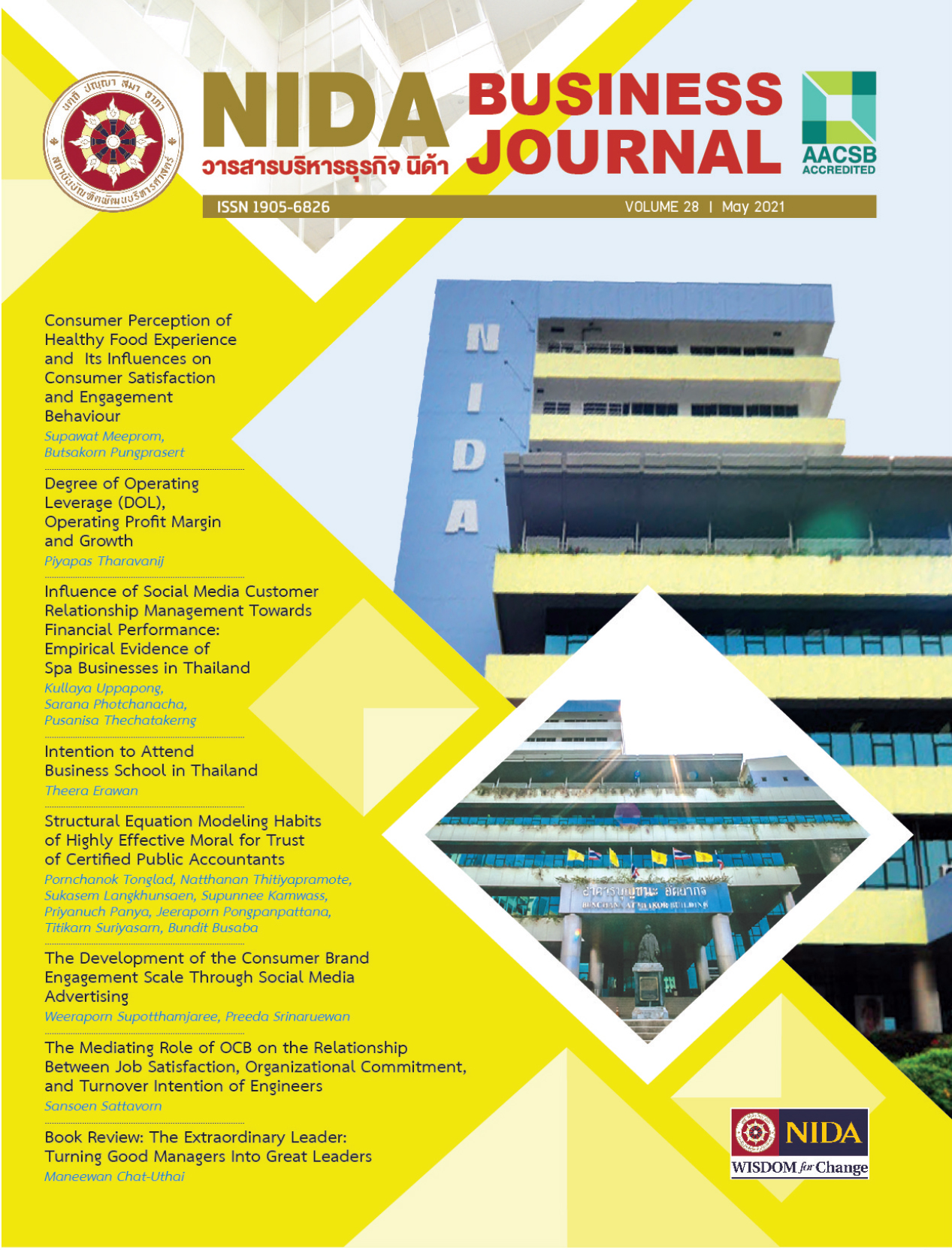การรับรู้จากประสบการณ์การบริโภคอาหารเพื่อสุขภาพ ที่ส่งผลต่อความพึงพอใจและการสร้างความผูกพัน ในมุมมองทางด้านพฤติกรรมของผู้บริโภค
คำสำคัญ:
การรับรู้จากประสบการณ์, ความพึงพอใจ, ความผูกพัน, ความตั้งใจซื้อ, พฤติกรรมผู้บริโภคบทคัดย่อ
แนวโน้มในการดูแลห่วงใยสุขภาพและความปลอดภัยในการบริโภคได้รับความนิยมมากยิ่งขึ้นอย่างต่อเนื่อง อาหารเพื่อสุขภาพจึงได้รับความนิยมเพิ่มขึ้นด้วย งานวิจัยนี้จึงมีวัตถุประสงค์เพื่อศึกษาการรับรู้จากประสบการณ์ของ ผู้บริโภคเนื้อไก่เพื่อสุขภาพที่ส่งผลต่อความพึงพอใจและการสร้างความผูกพันกับความตั้งใจซื้อในมุมมองทางด้านพฤติกรรม ผู้บริโภค โดยเก็บข้อมูลจากกลุ่มตัวอย่างจำนวน 487 ราย ที่เคยบริโภคเมนูเพื่อสุขภาพที่ทำมาจากไก่ KKU1 การวิจัยนี้ใช้ รูปแบบการวิเคราะห์ด้วยแบบจำลองสมการโครงสร้างเพื่อตอบสมมุติฐานที่ตั้งไว้ โดยผลการวิจัยพบว่าความพึงพอใจของ ผู้บริโภคทำหน้าที่เป็นตัวแปรส่งผ่านอิทธิพลเชิงบวกจากการรับรู้จากประสบการณ์ของผู้บริโภคไปยังความผูกพันและความ ตั้งใจซื้อ สอดคล้องกับทฤษฎีการแลกเปลี่ยนทางสังคม ซึ่งจะเกิดประโยชน์ต่อผู้ประกอบการหรือเกษตรกรให้สามารถพัฒนา การขับเคลื่อนเศรษฐกิจชุมชนให้ประสบความสำเร็จอย่างมีประสิทธิภาพ ตลอดจนมีการเติบโตได้อย่างยั่งยืนได้ต่อไป
References
Aaker, D. A., & Joachimsthaler, E. (2000). The brand relationship spectrum: The key to the brand architecture challenge. California Management Review, 42(4), 8-23.
Altschwager, T., Conduit, J., Bouzdine-Chameeva, T., & Goodman, S. (2017). Branded marketing events: Engaging Australian and French wine consumers. Journal of Service Theory and Practice, 27(2), 336-357. doi:10.1108/JSTP-04-2015-0108
Amilien, V., Tocco, B., & Strandbakken, P. (2019). At the heart of controversies: Hybrid forums as an experimental multi-actor tool to enhance sustainable practices in localized agro-food systems. British Food Journal, 121(12), 3151-3167.
Arbore, A., & Busacca, B. (2009). Customer satisfaction and dissatisfaction in retail banking: Exploring the asymmetric impact of attribute performances. Journal of Retailing and Consumer Services, 16(4), 271-280.
Boonkum, W., Chankitisaku, l., Srungboonmee, T., & Meeprom, S. (2020). Supply chain management for healthy chicken meat production (3 low chicken) from Farm-to-Fork in Khon Kaen province. Retrieved from Khon Kane: Thailand.
Bougie, R., Pieters, R., & Zeelenberg, M. (2003). Angry customers don’t come back, they get back: The experience and behavioral implications of anger and dissatisfaction in services. Journal of the Academy of Marketing Science, 31(4), 377-393.
Brakus, J. J., Schmitt, B. H., & Zarantonello, L. (2009). Brand experience: What is it? How is it measured? Does it affect loyalty? Journal of Marketing, 73(3), 52-68.
Cha, J., & Borchgrevink, C. P. (2019). Customers’ perceptions in value and food safety on customer satisfaction and loyalty in restaurant environments: moderating roles of gender and restaurant types. Journal of Quality Assurance in Hospitality & Tourism, 20(2), 143-161.
Chen, M. F. (2009). Attitude toward organic foods among Taiwanese as related to health consciousness, environmental attitudes, and the mediating effects of a healthy lifestyle. British Food Journal, 111(2), 165-178. doi:10.1108/00070700910931986
Churchill, G. A., & Surprenant, C. (1982). An investigation into the determinants of customer satisfaction. Journal of Marketing Research, 19(4), 491-504.
Claudy, M. C., Peterson, M., & Pagell, M. (2016). The roles of sustainability orientation and market knowledge competence in new product development success. Journal of Product Innovation Management, 33, 72-85.
Cropanzano, R., & Mitchell, M. S. (2005). Social exchange theory: An interdisciplinary review. Journal of Management, 31(6), 874-900.
Das, G., & Varshneya, G. (2017). Consumer emotions: Determinants and outcomes in a shopping mall. Journal of Retailing and Consumer Services, 38, 177-185.
Deng, X., & Srinivasan, R. (2013). When do transparent packages increase (or decrease) food consumption? Journal of Marketing, 77(4), 104-117.
Department of Livestock Development. (2018). Farmer Information in Thailand 2018. Retrieved from Bangkok: http://ict.dld.go.th/webnew/images/stories/stat_web/yearly/2561/land/T1-1.pdf
Dewnarain, S., Ramkissoon, H., & Mavondo, F. (2019). Social customer relationship management: An integrated conceptual framework. Journal of Hospitality Marketing & Management, 28(2), 172-188.
Doorn, J. v. (2011). Comment: Customer engagement: Essence, dimensionality, and boundaries. Journal of Service Research, 14(3), 280-282.
East, R., Singh, J., Wright, M., & Vanhuele, M. (2016). Consumer behaviour: Applications in marketing: Sage.
Fonte, M. (2013). Food consumption as social practice: Solidarity purchasing groups in Rome, Italy. Journal of Rural Studies, 32, 230-239.
Gengler, C. E., & Leszczyc, P. T. P. (1997). Using customer satisfaction research for relationship marketing: A direct marketing approach. Journal of Direct Marketing, 11(1), 23-29.
Goetzke, B., Nitzko, S., & Spiller, A. (2014). Consumption of organic and functional food. A matter of well-being and health? Appetite, 77, 96-105.
Grunert, K. G., Bredahl, L., & Brunsø, K. (2004). Consumer perception of meat quality and implications for product development in the meat sector–a review. Meat Science, 66(2), 259-272.
Gupta, S., Dasgupta, S., & Chaudhuri, R. (2012). Critical success factors for experiential marketing: Evidences from the Indian hospitality industry. International Journal of Services and Operations Management, 11(3), 314-334.
Hair, J., Black, W., Babin, B., & Anderson, R. (2018). Multivariate data analysis. Cengage. In.
Han, H., Nguyen, H. N., Song, H., Lee, S., & Chua, B.-L. (2019). Impact of functional/cognitive and emotional advertisements on image and repurchase intention. Journal of Hospitality Marketing & Management, 28(4), 446-471.
Harrigan, P., Evers, U., Miles, M. P., & Daly, T. (2018). Customer engagement and the relationship between involvement, engagement, self-brand connection and brand usage intent. Journal of Business Research, 88, 388-396.
Hoyer, W. D., Chandy, R., Dorotic, M., Krafft, M., & Singh, S. S. (2010). Consumer cocreation in new product development. Journal of Service Research, 13(3), 283-296.
Itani, O. S., Kassar, A.-N., & Loureiro, S. M. C. (2019). Value get, value give: The relationships among perceived value, relationship quality, customer engagement, and value consciousness. International Journal of Hospitality Management, 80, 78-90.
Jamal, A., & Sharifuddin, J. (2015). Perceived value and perceived usefulness of halal labeling: The role of religion and culture. Journal of Business Research, 68(5), 933-941.
Jeong, M., & Oh, H. (2017). Business-to-business social exchange relationship beyond trust and commitment. International Journal of Hospitality Management, 65(115-124).
Kasikorn Research Centre. (2017). The opportunities of health food. Retrieved from Bangkok: https://www.kasikornbank.com/th/business/sme/KSMEKnowledge/article/KSMEAnalysis/Documents/ HealthyFoodBusinessGrowth.pdf
Kitchen, P. J., & Schultz, D. E. (2001). The role of integrated communication in the interactive age. In Raising the Corporate Umbrella (pp. 82-114): Springer.
Liu, W.-K., Lee, Y.-S., & Hung, L.-M. (2017). The interrelationships among service quality, customer satisfaction, and customer loyalty: Examination of the fast-food industry. Journal of Foodservice Business Research, 20(2), 146-162.
McQuitty, S., Finn, A., & Wiley, J. B. (2000). Systematically varying consumer satisfaction and its implications for product choice. Academy of Marketing Science Review, 10(1), 231-254.
Melewar, T. C., Foroudi, P., Gupta, S., Kitchen Philip, J., & Foroudi Mohammad, M. (2017). Integrating identity, strategy and communications for trust, loyalty and commitment. European Journal of Marketing, 51(3), 572-604. doi:10.1108/EJM-08-2015-0616
Merrilees, B. (2016). Interactive brand experience pathways to customer-brand engagement and value co-creation. Journal of Product & Brand Management, 25(5), 402-408. doi:10.1108/JPBM-04-2016-1151
Montero-Vicente, L., Roig-Merino, B., Buitrago-Vera, J., & Sigalat-Signes, E. (2019). Characterisation of fresh fruit consumption in Spain based on food-related lifestyle. British Food Journal, 121(12), 3307- 3320. doi:10.1108/BFJ-04-2019-0253
Nyffenegger, B., Krohmer, H., Hoyer, W. D., & Malaer, L. (2015). Service brand relationship quality: Hot or cold? Journal of Service Research, 18(1), 90-106.
Oh, H. (1999). Service quality, customer satisfaction, and customer value: A holistic perspective. International Journal of Hospitality Management, 18(1), 67-82.
Oliver, R. L. (1993). Cognitive, affective, and attribute bases of the satisfaction response. Journal of Consumer Research, 20(3), 418-430.
Parasuram, A., Berry, L., & Zeithaml, V. (1991). Refinement and reassessment of the SERVQUAL instrument. Journal of Retail, 67, 1463-1467.
Paul, J., & Rana, J. (2012). Consumer behavior and purchase intention for organic food. Journal of Consumer Marketing.
Piqueras-Fiszman, B., & Spence, C. (2015). Sensory expectations based on product-extrinsic food cues: An interdisciplinary review of the empirical evidence and theoretical accounts. Food Quality and Preference, 40, 165-179.
Prentice, C., Wang, X., & Loureiro, S. M. C. (2019). The influence of brand experience and service quality on customer engagement. Journal of Retailing and Consumer Services, 50, 50-59.
Richardson, N. J., Shepherd, R., & Elliman, N. A. (1993). Current Attitudes and Future Influence on Meat Consumption in the U.K. Appetite, 21(1), 41-51. doi:https://doi.org/10.1006/appe.1993.1035
Rust, R. T., & Zahorik, A. J. (1993). Customer satisfaction, customer retention, and market share. Journal of Retailing, 69(2), 193-215.
Schmitt, B., Brakus, J. J., & Zarantonello, L. (2015). From experiential psychology to consumer experience. Journal of Consumer Psychology, 25(1), 166-171.
Singh, J., & Sirdeshmukh, D. (2000). Agency and trust mechanisms in consumer satisfaction and loyalty judgments. Journal of the Academy of Marketing Science, 28(1), 150-167.
Suki, N. M. (2016). Green product purchase intention: Impact of green brands, attitude, and knowledge. British Food Journal.
Sun-Waterhouse, D. (2011). The development of fruit-based functional foods targeting the health and wellness market: A review. International Journal of Food Science & Technology, 46(5), 899-920.
Torres, E. N., & Kline, S. (2013). From customer satisfaction to customer delight. International Journal of Contemporary Hospitality Management.
Troy, D. J., & Kerry, J. (2010). Consumer perception and the role of science in the meat industry. Meat Science, 86(1), 214-226.
Tudoran, A. A., Olsen, S. O., & Dopico, D. C. (2012). Satisfaction strength and intention to purchase a new product. Journal of Consumer Behaviour, 11(5), 391-405.
Tunim, S., Phasuk, Y., Aggrey, S. E., & Duangjinda, M. (2020). Gene expression of fatty acid binding protein genes and its relationship with fat deposition of Thai native crossbreed chickens. Asian-Australasian Journal of Animal Sciences, In press.
Valos, M. J., Maplestone, V. L., Polonsky, M. J., & Ewing, M. (2017). Integrating social media within an integrated marketing communication decision-making framework. Journal of Marketing Management, 33(17-18), 1522-1558.
Verleye, K., Gemmel, P., & Rangarajan, D. (2014). Managing engagement behaviors in a network of customers and stakeholders: Evidence from the nursing home sector. Journal of Service Research, 17(1), 68-84.
Vermeir, I., & Verbeke, W. (2006). Sustainable food consumption: Exploring the consumer “attitudebehavioral intention” gap. Journal of Agricultural and Environmental Ethics, 19(2), 169-194.
Wang, Y., Xiang, D., Yang, Z., & Ma, S. S. (2019). Unraveling customer sustainable consumption behaviors in sharing economy: A socio-economic approach based on social exchange theory. Journal of Cleaner Production, 208, 869-879.
World Health Organisation. (2016). Obesity and overweight. Retrieved from http://www.who.int/mediacentre/factsheets/fs311/en/
Wright, R. (2006). Consumer behaviour: Cengage learning EMEA.
Young, W., Hwang, K., McDonald, S., & Oates, C. J. (2010). Sustainable consumption: Green consumer behaviour when purchasing products. Sustainable Development, 18(1), 20-31.
Zander, K., Stolz, H., & Hamm, U. (2013). Promising ethical arguments for product differentiation in the organic food sector. A mixed methods research approach. Appetite, 62, 133-142.
Downloads
เผยแพร่แล้ว
How to Cite
ฉบับ
บท
License

This work is licensed under a Creative Commons Attribution-NonCommercial-NoDerivatives 4.0 International License.



